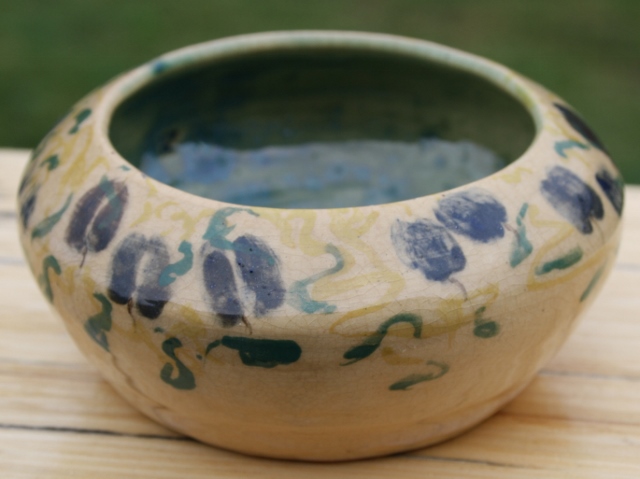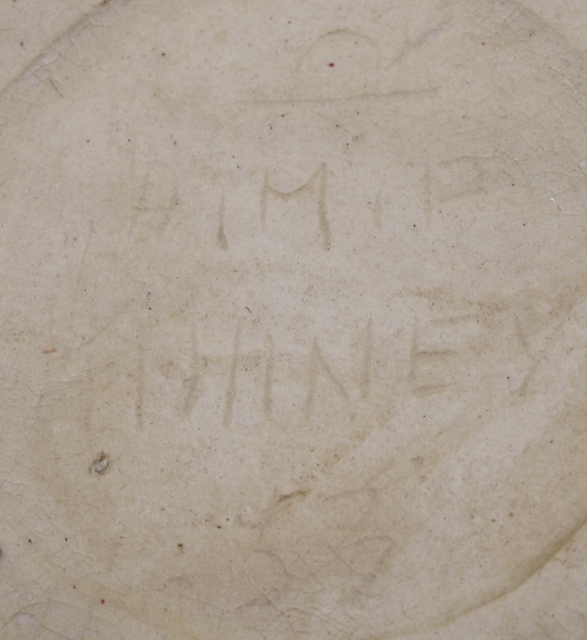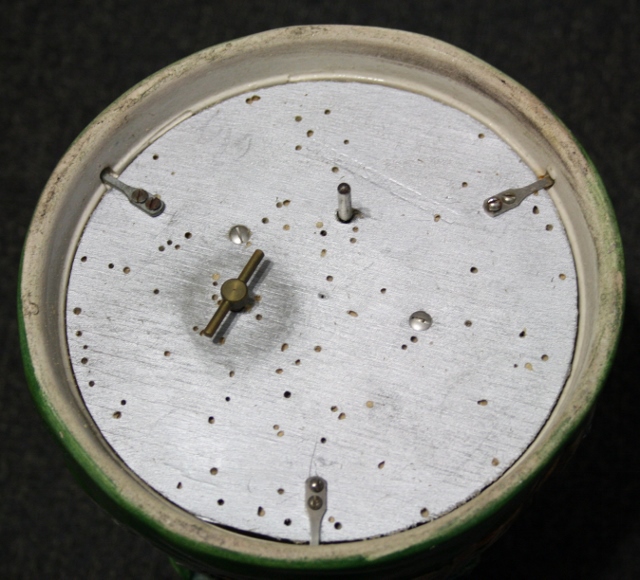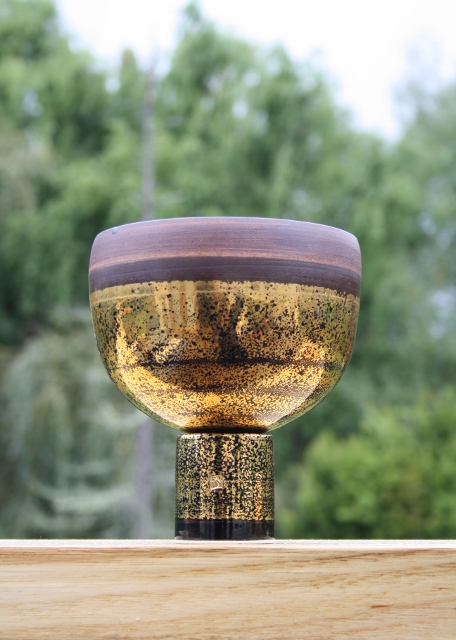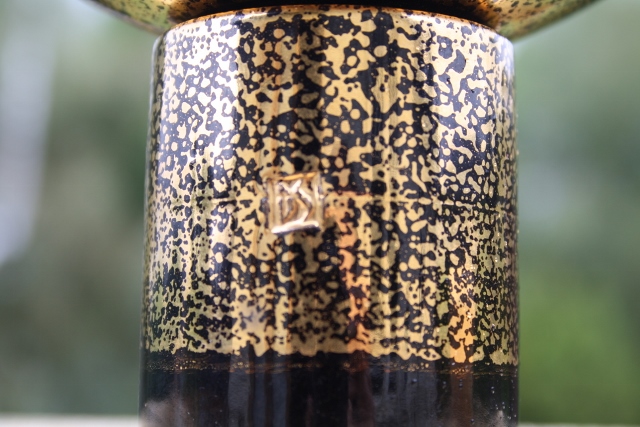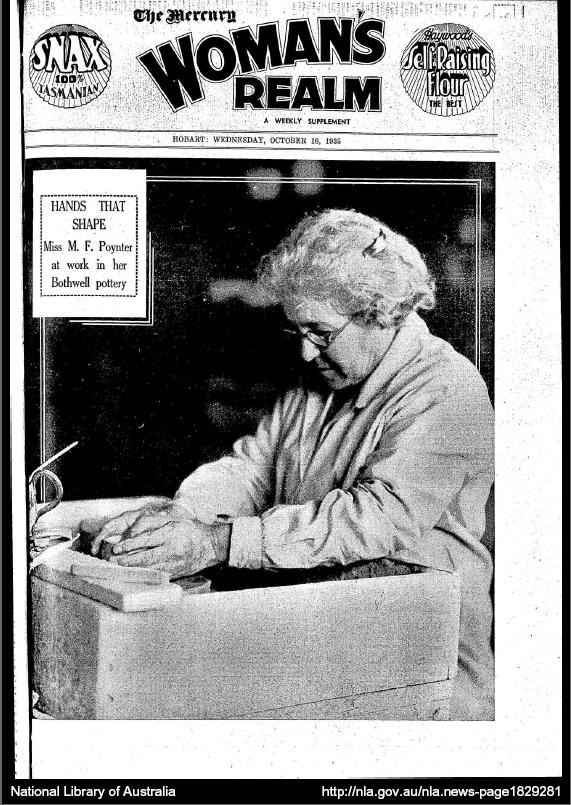Finds #4 – Alice Mylie Peppin Bowl
In what turned out to be a nice little purple patch for my treasure hunting I turned up this little Tasmanian gem in a local op shop while on the way to the post office.
Made by Alice Mylie Peppin (know as Mylie Peppin) in 1953 and hand painted with what looks to me to be a Fuchsia type floral design. I have a 10 pieces of Mylie’s works and although this is the oldest piece of hers that I own her body of works go back to the 1930’s and extend right through to the early 1990s.
In that time she achieved so much. She went from being a student Tasmanian pottery icon Maude Poynter to runnning a small commercial pottery from her back yard. She traveled overseas and spend time working and studying in England. She ran the Killiney potters group and managed to fit in a few pottery classes too. To say she kept herself busy was probably an understatement.
Forever the great experimenter it would have been sometimes hard to know who was learning more in her classes, the teacher or the student.
This willingness to experiment combined with a career lasting some 60 years means there is an interesting range or works to collect if you can find them. Perhaps unfairly, this mish-mash of styles has lead to a common phrase being used in conversation about Mylie’s works around dealers and collectors in Hobart and that is “The Good, The Bad and the Ugly”.
I do fear however that a large portion of “The Ugly” out there may be either poor imitations of her works or student potters who by coincidence have the same initials. I do know of at least one working potter with the same initials A.M. Penprase who was producing pottery towards the end of Mylie’s career. Thats not to say it’s ugly. It just must be noted that there are other AMPs out there.
This confusion with initials was a problem early on for a young Mylie Peppin who shared the same initials with her teacher Maude Poynter. This prompted Mylie to adopt a distinguishing mark of her own. To differentiate her works from her teachers she inscribed her works with a picture of a small hat with a feather stuck in it.
It’s not certain when Mylie stopped using her hat cypher but my pot from 1953 is pretty late for this mark.
Maybe you have to be Tasmanian to appreciate Mylie’s works. All I know is since moving from Sydney 5 years ago I have certainly developed a real affection for her style.
Tim
Posted: April 24th, 2014
at 7:26pm by Tim
Tagged with Australian Pottery, Maude Poynter, Mylie Peppin, Tasmanian Pottery
Categories: Australian Pottery,Finds
Comments: No comments
Finds #2 – Diana Waltzing Matilda Jug (UPDATE)
Just a quick update to to my May 1st 2011 post Finds #2 – Diana Waltzing Matilda Jug where I asked if anyone had a spare musical mechanism from a busted jug to replace the one mine was missing.
Well you wouldn’t believe it but I went to a local auction and what did I see but a box lot containing a badly broken Waltzing Matilda jug with it’s mechanism still in place. The replacement is not perfect but it works. The original plywood backing board has suffered an attack by some wood worm but it’s still holding together just nicely.
Not only did I get the mechanism for a price I was more than happy to pay but also thrown in with the lot were 2 Marutomo ware Don Bradman mugs one in perfect condition and another one in a broken but repairable state.
See! All good things come to those who wait.
On that subject I’ve been waiting a long time for a piece of Maude Poynter to turn up. Just sayin…….
Tim
Posted: April 24th, 2014
at 5:15pm by Tim
Tagged with Australian Pottery, Diana Pottery, Maude Poynter, NSW Pottery, Tasmanian Pottery, Waltzing Matilda
Categories: Australian Pottery,Finds
Comments: 1 comment
Finds #3 – Derek Smith Pedestal Bowl
With a full time job and helping with my partners Salamanca market stall on Saturdays it’s not often these days that I get a chance to do a little snooping around the op shops, and Antique shops of Hobart. Rarer than finding the time to go treasure hunting is, finding a treasure when I do go hunting.
I am very happy to report that recently I did have had a chance to get to a shop or two (albeit on the way home from a doctors appointment) and I DID find a treasure indeed! The Derek Smith pedestal vase pictured above is the latest addition to my all too long list of keepers (for the moment).
Standing about 16cm high and 13cm across the top it’s not a terribly imposing piece but it’s big enough to get noticed especially since it’s more than 3/4 gilded and mirror reflective!
There is not much I can add to the Derek Smith story that isn’t already covered by Judith at Australian Pottery at Bemboka on her Australian Pottery 1960’s to Date blog here: Known potter #10: Derek Smith.
Over on Flickr you will find the Identifying Australian Pottery 1960s to Date group which is also run by Judith which had a dedicated Astrix (*) topic dedicated to Derek Smith and a comprehensive list of the marks used throughout his career here: * Derek Smith.
Derek Smith is a Tasmanian icon of modern pottery surpassed only by Les Blakebrough in his celebrity to the point that if you were to tell a shop keeper down here that you collected Modern Tasmanian pottery the answer almost invariably comes back “do you collect Blakebrough or Derek Smith?” although having said that it can be a bit difficult to get anyone down here to look past the standard Campbell and McHugh.
Tim
Posted: April 24th, 2014
at 3:30pm by Tim
Tagged with Australian Pottery, Derek Smith, John Campbell, Les Blakebrough, McHugh Pottery, Tasmanian Pottery
Categories: Australian Pottery,Finds
Comments: No comments
Bits and Pieces #2 – Being Patient
While looking through the National Library’s Trove Website for newspaper articles on the Tasmanian potter Maude Poynter I came across an article from the Mercury dated April 5th 1924 describing an exhibition of Miss Poynters works at Hobart Town Hall.
The article goes to great lengths to describe the works on display by both Miss Poynter and Miss Mace (Violet Mace) that it really makes you wish they had taken a photo or two. Particularly of the Mah Jong set created by Miss Mace (where is it today?!!!).
One thing that struck me though was that in 1924 Miss Poynter was planning to upgrade to an electric furnace once the wires finally reached her home town of Bothwell in Tasmania. This struck a particular chord with me as a recent migrant to a semi rural part of the Apple Isle who is currently waiting on a cable (albeit a different kind of cable) to arrive in our town.
The modern day cable I speak of is the the long awaited roll out of the Government’s National Broadband Network (NBN). The first stage is complete and the lucky few at Midway Point have had their services switched on and are already enjoying high speed internet goodness. From what we can tell Kingston is next on the list for the roll out but that’s still more than 40kms “down the road” from us so we aren’t holding our breath for connection any time soon.
However, we do have an internet connection, we just want a better one. We don’t have to make do or find alternate ways of doing our business it just takes a a couple of seconds longer (or minutes depending on if the fog is blocking our wireless signal) to get things done compared to out big city counterparts or indeed the lucky few at Midway. I don’t know how we would cope waiting for something as important as electricity to makes its way this far south.
A year later though Maude returns to Hobart to hold another Exhibition with Miss Mace and in the Mercury article dated March 25th 1925 it is noted that “in view of the near approach of the supply of power to Bothwell some beautifully designed electric reading lamps were objects of special interest.”. To put this into a little more perspective, Hobart had its first electric street lamps switched on around 1897. Even my old home town of Hurstville in New South Wales had power by 1910 and was working to get the lines as far south as Sutherland by 1912.
But still Miss Poynter waits…
In June 1928 however, luck finally turns Maude’s way and we see in the June 22nd edition of the Examiner the final approval for connection of electricity to the Ratho pottery at Bothwell was granted.
Maude Poynter moved to Ratho at Bothwell in 1918 and had to wait 10 years to get her lights put on!
If Maude can wait 10 years I guess I’ll have to learn to be a little more patient waiting for slightly better internet…
A photo of Maude Poynter at work in her pottery taken from the Mercury’s “Woman’s Realm” supplement dated October 16th 1935. Interestingly, Maude is still using her old pedal powered potters wheel. Hopefully she has the electric light on though!
References:
POTTER’S ANCIENT ART. (1924, April 5). The Mercury (Hobart, Tas. : 1860-1954), p. 6. Retrieved July 10, 2011, from http://nla.gov.au/nla.news-article23727479
GENERAL NEWS ITEMS. (1925, March 21). The Mercury (Hobart, Tas. : 1860-1954), p. 13. Retrieved July 10, 2011, from http://nla.gov.au/nla.news-article23805368
BOTHWELL COUNCIL. (1928, June 22). Examiner (Launceston, Tas. : 1900-1954), p. 8 Edition: DAILY. Retrieved July 10, 2011, from http://nla.gov.au/nla.news-article51484669
Photo of Maude Poynter http://nla.gov.au/nla.news-page1829281
Posted: July 10th, 2011
at 11:58am by Tim
Tagged with Australian Pottery, Maude Poynter, Tasmanian Pottery, Violet Mace
Categories: Australian Pottery,Bits and Pieces
Comments: 1 comment
Out and About #1 – Saddlers Court Gallery
Last week, while entertaining some mainland visitors, we decided to take the lovely drive out to the historic town of Richmond (about 30 minutes drive from Hobart) for a spot of lunch before dropping our guests at the airport for their long trip home.
On the way back to the car after lunch we managed a quick stop off at Saddlers Court Gallery for a look at some fine modern Tasmanian, Australian pottery. The gallery contains works by Derek Smith, Sue Stack, Panogana Pottery by Bill Thomas, Zsolt Faludi, and Mark Knight just to mention a few and is well worth a look if you are visiting Richmond. The Saddlers Court website also says they carry pieces by Les Blakebrough but I didn’t see any on my visit. Having said that I’m not sure how up to date their site is as they don’t mention Mark Knight despite a comprehensive range being available in the gallery.
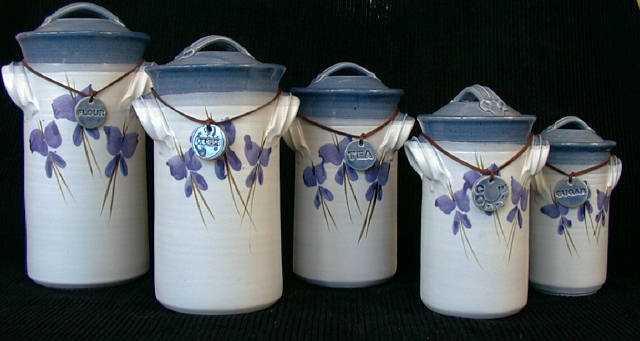
Set of Mark Knight Cannisters
I will also mention that there is far more to see at the Gallery than just Tasmanian pottery. There is also an interesting selection of paintings, prints, art glass, large and small works in wood as well as jewelery. All up more than 100 different Tasmanian artists and crafts people are represented at Saddlers Court.
The gallery is open from 10pm to 5pm daily and will open after hours for organised groups by prior arrangement only.
Posted: January 10th, 2010
at 1:52am by Tim
Tagged with Australian Pottery, Bill Thomas, Derek Smith, Les Blakebrough, Mark Knight, Modern Australian Pottery, Out and About, Panogana Pottery, Saddlers Court Gallery, Sue Stack, Tasmanian Pottery, Zsolt Faludi
Categories: Australian Pottery,Out and About
Comments: 4 comments

